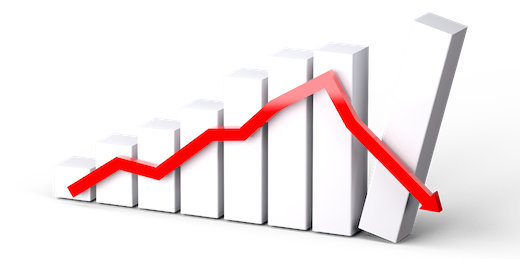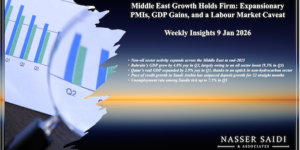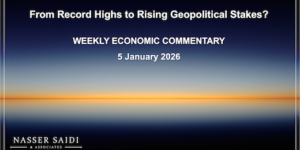Markets
As the US-China trade negotiations progress, and given the possibility of an extension of the deadline, equity markets edged higher across the globe including the Asia-Pacific (driven by China). However, last week saw the first outflows from emerging market debt and equity funds since Oct 2018. Among regional equity markets, it was a mixed picture as major markets closed higher (on the global rally) except Oman, Saudi Arabia and Egypt. Brent crude oil price hit a 2019 high, supported by OPEC’s ongoing supply cuts and in spite of higher US output, while gold prices were flat.
Global Developments
US/Americas:
- Durable goods orders in the US increased by 1.2% yoy in Dec (Nov: 1%), though orders for non-defense capital goods excluding aircraft – a proxy fir business spending plans – fell 0.7% (Nov: -1%).
- US manufacturing PMI dipped to 53.7 in Feb (Jan: 54.9), a 17-month low, thanks to a slowdown in production and new order growth; services PMI increased to 56.2 (Jan: 54.2), expanding the most since Jun. The US Composite PMI rose to an eight-month high of 55.8 in Feb from 54.4 in the previous month.
- Existing home sales in the US declined to a 3-year low, with sales dropping by 1.2% mom and by 8.5% yoy to 4.94mn units in Jan. The median existing house price increased 2.8% yoy to USD 247,500 in Jan – the smallest increase since Feb 2012.
- Initial jobless claims fell by 23k to 216k in the week ended Feb 16. The 4-weekmoving average rose 4k to 235,750, the highest level since Jan 2018.
Europe:
- The ZEW economic sentiment for Germany edged up to -13.4 points in Feb (Jan: -15.0); investors’ assessment of the economy’s current conditions however fell to 15.0 from 27.6.
- A breakdown of the German GDP data, which remained unchanged in Q4 2018, showed a boost from domestic spending, while inventories shaved off 0.6 ppts off GDP.
- Germany’s inflation rate slowed to a 11-month low of 1.4% yoy in Jan 2019 (Dec: 1.6%), as a result of falling energy prices (2.3% from Dec’s 4.9%).
- Germany’s manufacturing PMI fell to 47.6 in Feb, down from Jan’s 49.7 and the lowest since Dec 2012, as a result of a sharp drop in exports orders.
- The composite PMI for eurozone rose to 51.4 in Feb, up from 51 in Jan; however, this masks a drop in the manufacturing PMI which hit a 69-month low of 49.2 in Feb.
Asia Pacific:
- Inflation in Japan ticked up to 0.2% yoy in Jan (Dec: 0.3%) amid higher utility bills, but still further from the BoJ’s 2% inflation target. Core inflation excluding food items, increased by 0.8% yoy (Dec: 0.7%) while core-core-inflation (sans food and energy) grew 0..4% (0.3% in Dec).
- Japan’s core machinery orders fell by 0.1% mom to JPY 862.6bn in Dec, recording the second consecutive month of declines. Manufacturing orders slumped 8.5% in Dec following a 6.4% decline in Nov.
- Japan’s trade deficit widened to JPY 1.41trn (USD 12.8bn) in Jan, up 49.2% yoy, and the highest in nearly five years. Exports declined for the second month in a row (down 8.4% yoy), with exports to China down a whopping 17.4% – the sharpest fall since Jan 2016.
Bottom line:The slowdown in business spending, as seen from the PMI indicators, has been acknowledged by the Federal Reserve in its recent FOMC minutes. The picture in Europe continued to be bleak, with Eurozone manufacturing PMI registering its first contraction in 5 years and reports that Fitch had placed UK’s AA sovereign rating on Watch Negative citing uncertainty over the Brexit outcome. The latest ECB meeting minutes show a high likelihood of more long-term loans for banks. Germany gave mixed signals: while manufacturing posted another contraction reading, Q4 GDP breakdown showed healthy rise in consumption and investment; the country’s current account surplus (2018: USD 294bn) also remained the world’s largest for the third consecutive year: would this risk being Trump’s next “national security” threat – an argument for higher tariffs on German cars?
Regional Developments
- Bahrain’s non-oil exports grew by 9% yoy to BHD 2.286bn (USD 6.06bn) in 2018, with the top 10 partners – Saudi Arabia, UAE and Oman were the top three – accounting for about 66% of total value. Imports were up by 13% to BHD 5.593bn (USD 14.83bn), with China, UAE and the US top three import partners.
- Egypt issued USD 4bn in dollar denominated bonds, with the money raised to be used to finance the state budget. Most bids, in the 5-times oversubscribed sale, were for the longer maturity 10- and 30-year bonds.
- The money Egypt owes foreign oil companies dropped to USD 1bn by mid-Dec, after around USD 200mn was paid in arrears, according to the Al-Borsa
- Egypt’s food subsidy bill increased by 4.8% yoy to EGP 24.3bn in H1 of the 2018-19 financial year.
- Egypt’s transport minister disclosed plans toinvest over EGP 71bn (USD 4.05bn) to develop its ports to become an international transport and logistics hub.
- The African Development Bank revealed that it had it had supported Egypt with USD 1.5bn over the last three years: financing over 100 projects in Egypt, and funding projects worth more than USD 2.5bn.
- A meeting between the Emir ofKuwait and Saudi Arabia’s oil minister saw the latter expressing hope that oil production could be resumed from the Neutral Zone (which both countries share) this year. Resuming production could add up to 500k barrels per day each to the oil output of Saudi Arabia and Kuwait.
- Lebanon’s Real Estate Demand Index posted an increase of 14% yoy to a monthly average of 51.2 in Q4 2018 (Q3: 51.4), but remained 53.4% below the annual peak of 109.8 recorded in 2010.
- Bilateral non-oil trade between Oman and UAE, which had grown by 12.4% yoy to AED 36bn in 2017, reportedly grew to AED 32.5bn in Jan-Sep 2018.
- A total of 3500 Omanis were employed in the logistics sector last year, according to the minister of transport and communications. Plans are underway to create a further 2500 jobs in the sector.
- Saudi Arabia’s crown prince visited Pakistan, India and China last week, signing multiple agreements and investment deals.
- In Pakistan, USD 20bn worth investments were pledged, with most of the agreements focused on energy projects including a USD10bn refinery and petrochemicals complex. Ahead of the visit, Saudi’s energy minister disclosed that an agreement had been signed to supply Pakistan with crude oil to secure its fuel needs.
- In India, the Crown Prince signed agreements on investment infrastructure, housing sector and tourism; he expects investment opportunities worth more than USD 100bn over the next two years.
- In China, Aramco agreed to a joint venture with Norinco to develop a USD 10bn+ refining and petrochemical complex; an MoU with the PIF will enable it to support and develop manufacturing, power generation and emerging technologies over the next ten years; an agreement was reached to teach the Chinese language as a curriculum at all stages of education in schools and universities across Saudi Arabia.
- Saudi Arabia’s inflation fell by 0.3% mom and 1.9% yoy in Jan, as a result of a 7.7% dip in housing, water and energy prices.
- Saudi Arabia’s finance ministry issued SAR 9.376bn (USD 2.5bn) inits monthly domestic sukuk issuance program for Feb.
- Crude oil exports from Saudi Arabia declined by over half a million barrels per day (bpd) to 7.69mn bpd in Dec from 8.235mn bpd in Nov. inventories plunged by 2.84mn bpd mom to 205.38mn bpd in Dec, registering the lowest level in a decade.
- Saudi citizens working in the retail sector increased to 260k, with 48% of them women. Of the total 537,281 salespersons in the country’s retail sector, 48.4% were Saudis.
- Saudi Arabia launched work on the expansion of the King Khalid international airport, expected to cost SAR 2.21bn (USD 589mn). The airport will be able to accommodate 11mn passengers annually after completion of this work.
- The MENA region witnessed 26 IPOs in 2018, raising a total of USD 2.946bn, according to EY. The GCC recorded 18 IPOs valued at USD 2.5646bn. Saudi Arabia led in both IPO volume and value: 12 IPOs valued at USD 1.4724bn.
- Saudi Arabia’s holdings of US Treasury bills grew by 16.4% yoy and 1% mom to USD 171.6bn in Dec while the UAE also raised its holdings by 0.88% mom to USD 56.8bn in Dec 2018. Globally, China ranked the top holder of US debt instruments with USD 123trn, followed by Japan with USD 1.042trn.
UAE Focus
- Inflation in Abu Dhabi fell by 0.9% yoy- the lowest level since 2016 – but rose 1% mom in Jan.
- Money supply (M2) in the UAE declined by 0.2% mom to AED 1.3084trn in Jan. While total bank deposits fell by AED 1bn in Jan, government deposits increased by 1.26% mom to AED 297.6bn in Jan.
- Assets of UAE’s banks increased by 1.2% mom to AED 2.913trn in Jan, as per central bank statistics. Bank lending picked up by 0.3% mom to AED 1.662trn.
- UAE will keep water and electricity tariffs unchanged, according to the energy minister. He also disclosed that the UAE plans to introduce “soon” a law allowing the installation of solar panels on roofs of UAE buildings.
- Employees in the UAE banking sector rose to 40,159 in 2018 – the highest since 2015. employees at the 22 national banks account for almost 98% of the total.
- The DIFC Courts reported a 29% yoy uptick in cases to 670 last year; the volume of cases of the main Court of First Instance also ticked up by 50%. Two transnational disputes saw the value of cases rising to AED 10.2bn last year from just AED 400mn in 2017.
- Hotel supply in Dubai increased by 9.3% in Jan, according to STR Inc, while demand rose by 3.9%. Occupancy rates fellby 4.9% to 82.2% in Jan, while the average daily rates fell 11.4% yoy to AED 714.01 bringing down the revenue per available room to AED 586.79 (-15.8%).
- Apart from Emirati investors who invested AED11.5bn in Dubai’s real estate sector during Jan-Nov 2018, the major expat investors were Indians (AED10.8bn), British (AED 4.3bn), Pakistanis (AED 2.8bn) and Jordanians (AED 1.5bn). Together the 4 expat communities accounted for nearly one-third of the total AED 62bn investments recorded in Jan-Nov 2018.
Media Review
How no-deal sets the stage for Brexit’s biggest negotiations
https://www.ft.com/content/738a995a-35ca-11e9-bd3a-8b2a211d90d5
British voters are unimpressed by Theresa May’s Brexit deal
https://www.economist.com/graphic-detail/2019/02/23/british-voters-are-unimpressed-by-theresa-mays-brexit-deal
FinTech in India & regulations
https://qz.com/india/1556915/paytm-policybazaar-aside-2018-was-crappy-for-fintech-in-india/
The AI Road to Serfdom?
https://www.project-syndicate.org/commentary/automation-may-not-boost-worker-income-by-robert-skidelsky-2019-02
Powered by:









